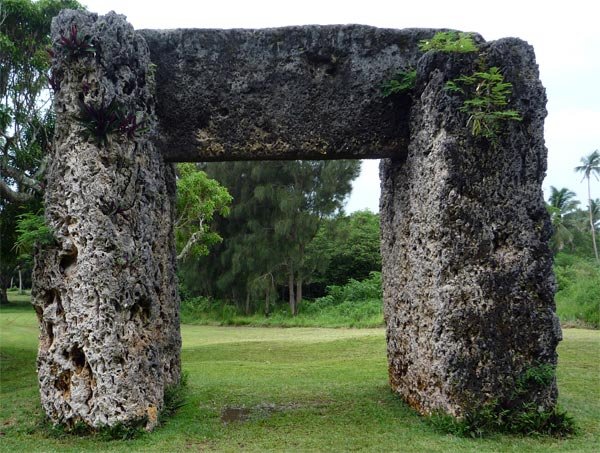
The kingdom of Tonga is a Polynesian sovereign state and archipelago comprising nearly two hundred islands with around a quarter of them inhabited. The date that the first occupation of the islands took place is ambiguous - as is the dating of most of the archaeological sites in the region. However, the mainstream opinion suggests the first settlers of the islands arrived in around 1500 BC with the oldest occupied site found on the island of Tongatapu, where the unusual megalithic monument exists.
The Ha’amonga ‘a Maui is located about 30 km from Nuku-alofa, the capital city of Tongatapu. The structure is a megalithic trilithon that was said to have been built in about 1200 AD by the king of the time, probably as the entrance to his royal compound Heketa. According to a Tonga nobleman, the trilithon was built to symbolize the brotherhood of the sons of king Tuʻitātui.
A trilithon is a structure that consists of two vertical stones with a third stone supporting the top. Many would be familiar with the most famous trilithons that can be seen at Stonehenge in the United Kingdom. This specific one consists of three coral limestone slabs creating a structure of about 5.2 m high, 5.8 m long and 1.4 m wide with each stone weighing approximately 30 to 40 tonnes.
There are many legends about the Ha’amonga ‘a Maui. The most prominent story says that the trilithon was made by the Maui demigod(s) because no other mortals would be able to handle such giant stones. It was said that the Maui obtained the stones and carried them on a giant canoe. Maui were legendary demi-gods and they are present in most of the folklore of the Pacific islands. There were four brothers all with the name Maui, powerful with supernatural powers. Hawaii, Tonga, Tahiti and New Zealand all have legends related to the Maui, the first inhabitants of all those islands. But one of the most interesting aspects of the descriptions of Maui demigods is their interest in humans and their efforts to seek immortality for the human race – a topic that we will discuss another time.
The king of Tonga, Taufa’ahau Tupou IV, suggested in 1967 that the trilithon also had astronomical significance related to solstices and equinoxes. However, there is no evidence to support this perspective.
There still remains doubt as to whether the Ha’amonga ‘a Maui was really built for a mortal king of the kingdom of the Tongas in 1200 AD, or whether it came much earlier. It certainly bears a strong resemblance to prehistoric trilithons around the world, suggesting it is much older than 800 years. If the latter is true, the questions remain - why was it built and by whom?
By John Black
http://www.ancient-origins.net/ancient-places-oceania/megalithic-gate-haamonga-maui-001187
Hi! I am a robot. I just upvoted you! I found similar content that readers might be interested in:
http://www.ancient-origins.net/ancient-places-oceania/megalithic-gate-haamonga-maui-001187
Downvoting a post can decrease pending rewards and make it less visible. Common reasons:
Submit